Are you a Quiet Speculation member?
If not, now is a perfect time to join up! Our powerful tools, breaking-news analysis, and exclusive Discord channel will make sure you stay up to date and ahead of the curve.
And now begins the month of terrors, when the grimmest of horrors arise from parts unknown to once again plague humanity until banished by November's dawn. Yes, it's October, and that means it's Pumpkin Spice Everything season for America. Perhaps those of an international persuasion are spared from this most suburban of afflictions, I know not. I know only that everywhere I go, there's naught but advertisements for products needlessly bearing overtones of cinnamon and clove, vying for the dollar of those most basic among us. And also it's time for the September metagame update. But that seems minor in comparison.
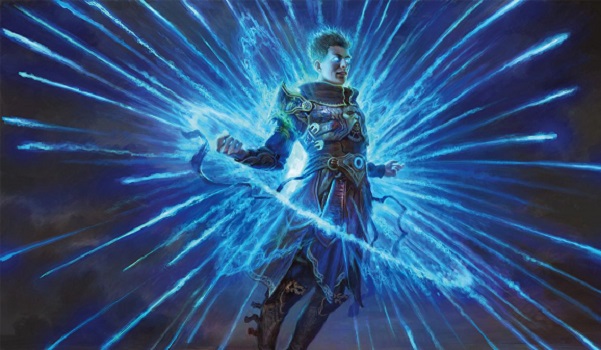
September represented a bit of a lull in the metagame. Innistrad: Midnight Hunt came in without much impact and everyone is just waiting around to see what Innistrad: Crimson Vow brings. Consequently, there was only one extra Premier event and overall format engagement was down. It's been an odd year for month-to-month numbers overall, and I have no idea why. I would guess there's some burnout coupled with local paper events taking back online players, but it is quite a turnaround from last year.
September Metagame
To make the tier list, a given deck has to beat the overall average population for the month. The average is my estimate for how many results a given deck “should” produce on MTGO. Being a tiered deck requires 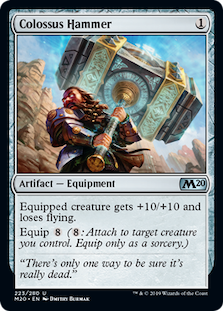 being better than “good enough;” in September the average population was 6.55, meaning a deck needed 7 results to beat the average and make Tier 3. This is the third month in a row that's been the case. Which is highly unusual, but then again these haven't been the most typical run of months. July had two breakout decks, two midtier decks and a ton of Tier 3's. August saw the data flatten but not dramatically expand. And September followed on from that, as will be clear shortly.
being better than “good enough;” in September the average population was 6.55, meaning a deck needed 7 results to beat the average and make Tier 3. This is the third month in a row that's been the case. Which is highly unusual, but then again these haven't been the most typical run of months. July had two breakout decks, two midtier decks and a ton of Tier 3's. August saw the data flatten but not dramatically expand. And September followed on from that, as will be clear shortly.
Tier 3 begins with decks posting 7 results. Then we go one standard deviation above average to set the limit of Tier 3 and cutoff for Tier 2. The STdev was 10.82, which means that means Tier 3 runs to 18. Again, it's the starting point to the cutoff, then one above for the next Tier. Therefore Tier 2 starts with 19 results and runs to 30. Subsequently, to make Tier 1, 31 decks are required. Which is exactly the same as it was in August.
The Tier Data
Which might lead on to think that the overall data would be similar to August's. It isn't. Unique decks are down from 80 to 65. Which is on the low end for the year, just above the low point in July. I suspect that where August was about exploration, September was all about refinement. The metagame, specifically the top few decks, were well known enough to actually prepare against. At least, the developments I saw certainly reflect such movements.
The total population was also way down. August reversed a downward trend by spiking to 515 decks. September only managed 426, which is still up from July but well below the yearly norm. And this is with help from non-Wizards tournaments. I found a number of Preliminary-like events on MTGMelee and added them in, which was fortunate. Without them, September would have been below 400 for the first time since I started doing these monthly updates again. There were slightly fewer events in September than August, so I can only guess that the Preliminaries were significantly smaller this month. Consequently, there are only 13 decks in the tier list which is well below average.
While number of tiered decks is down significantly, the effect was felt entirely by Tier 3. The total number of decks in Tiers 1-2 are the same. This strongly indicates that the format was just as dynamic and competitive in September as August. The reduction is therefore due to the low population and not due to decks being squeezed out. It would be a different story if one deck was sucking up all the slots as happened with 4-Color Omnath prior to the bans.
Hammer Time is holding onto the top slot by about the same margin as in August. However, everything else has changed. UR Thresh is now in third place under the surging UW Control. Cascade Crashers just made Tier 1 while Blue Living End nearly fell into Tier 3. This is all connected, which is a clear sign of metagame evolution. Decks are adapting to the top decks and those that are more easily targeted are falling off. This indicates that the metagame is in a fairly healthy place. Especially since Burn's back in Tier 1.
Cascade Crashed
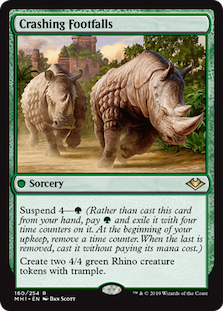 The biggest story is that both Cascade decks fell hard in September. Cascade Crashers just barely stayed out of Tier 2 and Living End just kept its head above Tier 3. This is a huge fall in fortune for both decks, which have been on an upward trajectory since June when MH2 brought in Shardless Agent and made both decks viable. This is a bit odd as there's nothing new in the cardpool to answer them, and in fact, players are playing the same answers now as in June. As always with MTGO, it may simply be that pilots got bored and switched decks, but I think there's more going on.
The biggest story is that both Cascade decks fell hard in September. Cascade Crashers just barely stayed out of Tier 2 and Living End just kept its head above Tier 3. This is a huge fall in fortune for both decks, which have been on an upward trajectory since June when MH2 brought in Shardless Agent and made both decks viable. This is a bit odd as there's nothing new in the cardpool to answer them, and in fact, players are playing the same answers now as in June. As always with MTGO, it may simply be that pilots got bored and switched decks, but I think there's more going on.
Small Change, Big Payoff
Specifically, the rise of UW Control to Tier 1 status. It was mid-Tier 3 in August after not appearing in the rankings in July, and has since exploded all over MTGO. Some of that definitely is thanks to Yellowhat and Wato0's results as well as LSV extolling the deck. However, the key was that other players were able to match their results. The 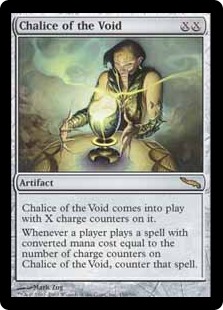 aforementioned players, being who they are, routinely do well with decks that nobody else can. In fact, I remember it being a joke in the Pro community that only Wafo-Tapa can win with Wafo-Tapa decks. However, this latest iteration is a deck that doesn't require complete mastery to run well while simultaneously being very well positioned.
aforementioned players, being who they are, routinely do well with decks that nobody else can. In fact, I remember it being a joke in the Pro community that only Wafo-Tapa can win with Wafo-Tapa decks. However, this latest iteration is a deck that doesn't require complete mastery to run well while simultaneously being very well positioned.
The key is maindeck Chalice of the Void. Sometimes that card just wins games by itself, and it's particularly devastating coupled with Teferi, Time Raveler against the Cascade decks (hence their decline). More importantly, it builds in some forgiveness for less experienced players. Playing control is very hard and requires making a lot of decisions correctly, leaving little room for mistakes. Thus it's an archetype that rewards strong players and punishes weaker ones. Chalice restricts the number of relevant cards, which makes threat assessment much simpler. Suddenly, the question against Cascade is whether to answer the actual threat being played rather than worrying about leaving the door open for the board to be flooded. It's hardly perfect, but making a deck even slightly easier to play while improving its positioning is a great way to attract players, and that's exactly what happened in September.
Burn's Back
I noted two years ago that Prowess and Burn compete in the same space and are better in different metagames. With Prowess completely disappearing, Burn was primed for the return to prominence we're seeing now. The key is the prevalence of removal, and cheap removal is at an all-time high. Burn doesn't care if its creatures die as long as they can 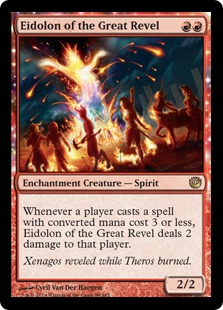 bash in any amount of damage. Prowess needs its creatures to stick around, and so the current format is very unwelcoming.
bash in any amount of damage. Prowess needs its creatures to stick around, and so the current format is very unwelcoming.
What's interesting is that some players are trying to innovate with Burn, and it isn't working. The vast majority of Burn decks look the same as Burn did in 2019. Some of these decks also run Lurrus of the Dream-Den as a companion, but far from the majority. At the same time, some players are trying to better utilize Lurrus by replacing Skewer the Critics with Dragon's Rage Channeler and shaving Rift Bolt and lands for Mishra's Bauble. In theory, this lets Burn grind better into the long game.
In practice, it isn't working out. The Channeler version does much worse than traditional Burn with or without Lurrus. The key is that DRC and Bauble are support for Lurrus and not the core strategy. Burn doesn't need to go long it needs to go face, and trying to change that isn't beneficial. Sometimes classics are classics for a reason.
Power Rankings
Tracking the metagame in terms of population is standard practice. However, how do results actually factor in? Better decks should also have better results. In an effort to measure this, I use a power ranking system in addition to the prevalence list. By doing so, I measure the 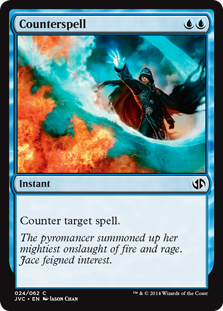 relative strengths of each deck within the metagame. The population method gives a decks that consistently just squeaks into Top 32 the same weight as one that Top 8’s. Using a power ranking rewards good results and moves the winningest decks to the top of the pile and better reflects its metagame potential.
relative strengths of each deck within the metagame. The population method gives a decks that consistently just squeaks into Top 32 the same weight as one that Top 8’s. Using a power ranking rewards good results and moves the winningest decks to the top of the pile and better reflects its metagame potential.
Points are awarded based on the population of the event. Preliminaries award points for record (1 for 3 wins, 2 for 4 wins, 3 for 5) and Challenges are scored 3 points for Top 8, 2 for Top 16, 1 for Top 32. If I can find them, non-Wizards events will be awarded points the same as Challenges or Preliminaries are depending on what the event in question reports/behaves like. Super Qualifiers and similar higher-level events get an extra point if they’re over 200 players, and a fifth for over 400 players. There was a single Showcase Qualifier awarding 4 points in September and no events that awarded 5 points.
The Power Tiers
Just like with population, the total points were down in September. This tracks given the population, but the scale of the drop off is astounding. August had 888 total points while September barely managed 707. The events from MTGMelee saved September from being the smallest point total once again. I did look around for other sources, but the most common reporting method is Top 8 only. That doesn't tell me anything about the competitiveness of the tournament so I really can't evaluate them. Which isn't a problem now, but paper events tend to be reported like that which will soon be a problem. I may have to completely redo the system.
The average points were 10.88, which means that 11 points makes Tier 3. It's the same as August, though I was fudging last month. Anyway, the STDev was 17.76, which is fairly average again though on the lower end. Thus add 18 to the starting point and Tier 3 runs to 29 points. Tier 2 starts with 30 points and runs to 48. Tier 1 requires at least 49 points.
The list stayed basically the same this time around. Crashers falling into Tier 2 was the only shift. What is notable is that everything in Tiers 1-2 are comfortably in their tier. Nothing's even borderline. It means that the population figures were a pretty accurate reflection of overall decks strength. Relative strength is a different matter as there's considerable shuffling around within the Tiers. Burn earned the second most points in September to jump 2 slots. As I've always said that population doesn't measure strength as well as it does popularity.
Going to the Zoo
I'd also like to highlight the only deck to make the power rankings but not population. Right 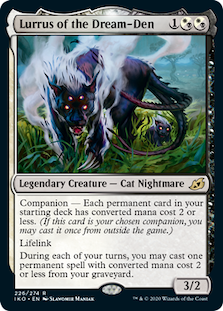 after MH2 there was an attempt to revive Domain Zoo which ultimately fizzled out. The deck had some impressive threats but that's just not good enough anymore. It wasn't fast enough to race aggro and couldn't grind or disrupt its way through slower decks or combo. However, September's data sees another attempt to make the archetype work actually make Tier 3 on power.
after MH2 there was an attempt to revive Domain Zoo which ultimately fizzled out. The deck had some impressive threats but that's just not good enough anymore. It wasn't fast enough to race aggro and couldn't grind or disrupt its way through slower decks or combo. However, September's data sees another attempt to make the archetype work actually make Tier 3 on power.
This new version gives up actually playing five colors of spells and Scion of Draco in order to run Lurrus as a companion. It can nonetheless access five basic types thanks to Triomes, so Tribal Flames is still used, but the core strategy is Jund aggro. And after board it goes 4-Color with either white or blue spells (white is far more common from what I've seen). This is working, but it's also treading very close on Jund Saga's turf. I'll be interested to see if they can coexist.
Average Power Rankings
Finally, we come to the average power rankings. These are found by taking total points earned and dividing it by total decks, which measures points per deck. I use this to measure strength vs. popularity. Measuring deck strength is hard. There is no Wins-Above-Replacement metric for Magic, and I'm not certain that one could be credibly devised. The 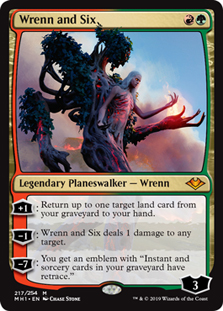 game is too complex and power is very contextual. Using the power rankings certainly helps, and serves to show how justified a deck’s popularity is. However, more popular decks will still necessarily earn a lot of points. Which tracks, but also means that the top tier doesn't move much between population and power, and obscures whether they really earned their position.
game is too complex and power is very contextual. Using the power rankings certainly helps, and serves to show how justified a deck’s popularity is. However, more popular decks will still necessarily earn a lot of points. Which tracks, but also means that the top tier doesn't move much between population and power, and obscures whether they really earned their position.
This is where the averaging comes in. Decks that earn a lot of points because they get a lot of results will do worse than decks that win more events, indicating which deck actually performs better. A higher average indicates lots of high finishes, where low averages result from mediocre performances and high population. Lower-tier decks typically do very well here, likely due to their pilots being enthusiasts. So be careful about reading too much into the results.
The Real Story
When considering the average points, the key is to look at how far-off a deck is from the baseline stat (the overall average of points/population). The closer a deck’s performance to the baseline, the more likely it is to be performing close to its “true” potential. A deck that is exactly average would therefore perform exactly as well as expected. The further away the greater the deviation from average, the more a deck under- or over-performs. On the low end, the deck’s placing was mainly due to population rather than power, which suggests it’s overrated. A high-scoring deck is the opposite.
Low tier decks tend to do better than high tier decks in these standings. This is usually because they're piloted by enthusiasts and are taking advantage of a gap in the metagame and/or surprising opponents. That doesn't mean they're not underrated, but it does mean be careful. The question is not whether a given low tier deck does well in a given month but whether or not it can sustain its position.
As my earlier disclaimer predicted, it's the lowest ranked deck with the best average. Now we see if Lurrus Zoo can maintain its position or if it was a fluke. Burn gets the trophy for deck of the month as the highest tiered deck above baseline, but it is quite interesting that all the other Tier 1 decks are below baseline by enough to consider it an actual underperformance. It will be interesting to see how this plays out next month.
Until the Next Shakeup
The year of unending spoilers will finally come to an end with Crimson Vow. If it's anything like Midnight Hunt, I'd anticipate no real changes to Modern, but there's no way to see. I just have to collect and process the data and see what happens.





